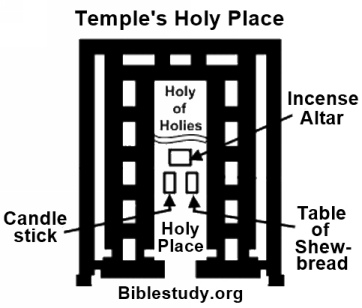Frankincense is a gum resin obtained from trees in the genus Boswllia. It is extracted by making deep incisions into the tree trunk then collecting the amber-colored resin that comes out (Tyndale Bible Dictionary). It is then ground into a powder for use as incense. When burned, frankincense produces a steady bright white flame that can last a long time.
Frankincense appears 17 times in the King James Bible. In the Old Testament, it is derived from the Hebrew word lebonah (Strong's #H3828) used to designate the aromatic resin. Lebonah is incorrectly recorded as "incense" and should be translated as this resin in six additional KJV places (Isaiah 43:23, 60:6, 66:3, Jeremiah 6:20, 17:26 and 41:5). This spice, in the New Testament, occurs twice and comes from the Greek libanos (Strong's #G3030).
The best quality of this spice was imported to Israel from Arabia (Isaiah 60:6). It was so highly prized that it, along with several other spices, were stockpiled in Jerusalem's temple (1Chronicles 9:29, Nehemiah 13:5).
Sacred and Personal Uses
Frankincense was added to several offerings made before God in the wilderness tabernacle (then later the temple, Leviticus 2:1 - 2, 15 - 16, 6:15).

God gave Moses a recipe for creating an incense that would burn in the Holy Place (Exodus 30:34 - 38). The Holy Place was in front of the Holy the Holies (where the Ark of the Covenant was located) but separated from it by a thick veil.
The divine mixture called for three finely ground spices along with pure frankincense. Any Israelite who attempted to make incense using the same holy formula, or even to reproduce its fragrance using other spices, would be severely punished by the Eternal!
A special table made of pure gold, called the table of shewbread, existed in the Holy Place. On it were placed twelve loaves of unleavened bread that were arranged six in a row (Josephus states they were placed in two heaps, Antiquities of the Jews, Book 3, Chapter 10, Section 7). Near the bread was placed frankincense in two cups. On each weekly Sabbath the bread and the spice, which stood as a memorial, were changed (Leviticus 24:5 - 8).
King Solomon had frankincense burned in front of his huge wedding procession as it travelled to his bride's house.
Who is this coming up out of the wilderness like pillars of smoke, perfumed with myrrh and frankincense, from all the merchant’s fragrant powders? (Song of Solomon 3:6, HBFV).
Gifts for the King
The Magi who visited baby Jesus were high-level Parthian priests miraculously informed of his upcoming birth roughly two years before it took place! They undertook the long and arduous journey to Judea so that they could worship the arrival of the "King of the Jews" (Matthew 2:1 - 2, 11).
The Magi's huge caravan carried large amounts of pure gold, frankincense and myrrh that were royal gifts of the highest quality. When they arrived in Bethlehem, several weeks after Christ was born, they presented their gifts.
And when they had come into the house, they found the little Child with Mary His mother, and they bowed down and worshiped Him; then they opened their treasures and presented their gifts to Him - gold and frankincense and myrrh. (Matthew 2:11, HBFV).
The gifts represented God's love and care for his Son, who would soon have to flee Herod the Great's wrath (Matthew 2:13 - 15).
Prophetic Spice
In the End Time, the world's Babylonish religious system headed by the False Prophet, and the city from which he rules, will be completely destroyed (Revelation 17:16 - 18:24). The merchants of the world, who grew rich selling goods to this system, will greatly mourn the loss of business! One of the many expensive products they will no longer be able to sell is frankincense.
And the merchants of the earth will weep and mourn over her, because no one will buy their merchandise any more: The merchandise of gold, and silver, and precious stones, and pearls, and fine linen . . .
And cinnamon, and incense, and ointment, and frankincense, and wine, and oil, and fine flour . . . (Revelation 18:11 - 13, HBFV).